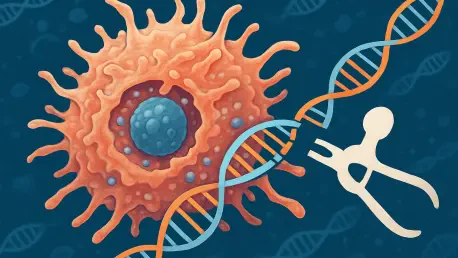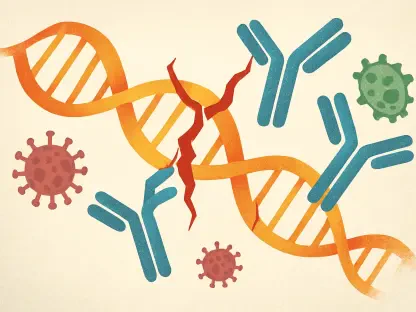What happens when the body’s tiniest defenders hold the key to battling some of humanity’s deadliest diseases? Macrophages, the immune system’s first line of defense, are microscopic powerhouses that detect and destroy pathogens while rallying other cells to fight. Yet, their inner workings have long remained a mystery—until now. A groundbreaking study has harnessed the precision of gene editing and the analytical might of artificial intelligence to uncover the molecular secrets of these vital cells, offering a glimpse into how they balance rapid response with pinpoint accuracy. This exploration promises to redefine approaches to infections and immune disorders in an era desperate for innovative solutions.
Unlocking the Body’s First Line of Defense
Macrophages stand as sentinels, patrolling the body for invaders like bacteria and viruses. Their role extends beyond mere attack; they act as conductors of the immune orchestra, signaling other cells to join the battle. This dual responsibility makes them indispensable, yet incredibly complex, as they must avoid both hesitation, which could let infections spread, and overzealousness, which might trigger harmful inflammation. Recent research from leading scientists at esteemed institutions has cracked open this cellular black box, revealing how these defenders operate under pressure.
At the heart of this discovery lies a fusion of cutting-edge tools that map out the dynamic behavior of macrophages. By peering into their genetic and molecular activities, scientists have begun to understand the intricate dance of activation and regulation. This insight is not just academic—it holds the potential to transform how medical professionals address everything from sepsis to chronic autoimmune conditions, marking a pivotal moment in immunology.
Why Macrophage Immunity Matters More Than Ever
In a world grappling with antibiotic resistance and novel viral outbreaks, the stakes for understanding immune responses have never been higher. Macrophages often determine whether an infection is swiftly contained or spirals into a life-threatening crisis. Their ability to engulf pathogens and alert the broader immune system positions them as critical players in health outcomes, especially when traditional treatments falter against evolving threats.
This research tackles a core challenge: decoding the mechanisms that prevent macrophages from misfiring. An underactive response can leave the body vulnerable, while an overactive one risks damaging healthy tissues through excessive inflammation. With global health challenges mounting, these findings offer a beacon of hope, pointing toward therapies that could fine-tune immune reactions to match specific dangers, potentially saving countless lives.
Peering into the Molecular Machinery of Macrophages
Delving deeper, the study employs a trio of revolutionary techniques to dissect macrophage behavior with unprecedented detail. Time-resolved analysis, using single-cell RNA sequencing, tracks how gene activity and DNA accessibility shift moment by moment as these cells respond to stimuli mimicking bacterial and viral attacks. This creates a vivid timeline of immune activation, showing exactly when and how macrophages spring into action.
Complementing this, CRISPR gene editing has been used to generate hundreds of gene knockouts, pinpointing dozens of regulatory proteins that govern these responses. From well-known pathways like JAK-STAT to lesser-known players such as splicing factors and chromatin regulators, the research uncovers a vast network steering immune precision. Additionally, it reveals the ancient origins of macrophage functions, tracing their roots to primitive organisms like sponges, highlighting an evolutionary depth that belies their simple reputation as mere pathogen eaters.
These combined methods paint a granular picture of adaptation in real time. Such clarity provides a foundation for targeting specific regulators, potentially allowing scientists to dial up or down immune activity as needed. This level of control could redefine therapeutic strategies for a range of conditions, from acute infections to long-term inflammatory diseases.
Voices from the Frontier of Immunology Research
From the forefront of this scientific breakthrough come compelling insights from key researchers. Christoph Bock, a leading figure in the study, underscores the power of technology in this realm: “CRISPR and machine learning let us unravel an ancient immune system with a detail never seen before, exposing regulators that were completely unknown until now.” This statement reflects the excitement surrounding the ability to dissect complex biology with modern tools.
Matthias Farlik, a co-author of the research, adds a practical perspective: “Mapping these molecular timelines paves the way for therapies that could adjust macrophage behavior during infections or autoimmune flare-ups.” Such expert voices emphasize the dual impact of this work—deepening fundamental knowledge while opening doors to clinical applications. The rigorous data behind these claims, drawn from extensive computational analysis, further cements the study’s credibility, showing how AI sifted through massive datasets to spot hidden patterns in immune control.
Applying the Science: Strategies for Harnessing Macrophage Power
Turning discovery into action, this research offers concrete pathways for researchers and clinicians to exploit these findings. One approach focuses on targeted immune modulation by zeroing in on specific regulatory proteins like JAK-STAT or newly identified chromatin regulators. Developing drugs to enhance or suppress macrophage activity could address critical conditions such as sepsis or persistent inflammation, providing tailored solutions to urgent medical needs.
Another promising avenue lies in personalized therapies. By leveraging single-cell RNA sequencing, medical teams could map a patient’s unique macrophage activity, customizing treatments to align with individual immune profiles. Meanwhile, AI-driven drug discovery, as showcased in the study, offers a faster route to identifying therapeutic targets by predicting how genetic edits might alter cellular behavior, streamlining the journey from lab to bedside.
These strategies form a practical blueprint for bridging molecular insights with real-world impact. Biotech innovators can use this roadmap to push boundaries, crafting interventions that are both precise and scalable. As these ideas take root, the potential to revolutionize immune-based treatments becomes not just a possibility, but an imminent reality waiting to unfold.
Looking back, the journey of decoding macrophage immunity through gene editing and AI stands as a testament to human ingenuity. The meticulous work of mapping molecular timelines and identifying regulatory networks laid a robust groundwork for future innovation. Moving forward, the next steps involve accelerating the development of targeted drugs and personalized therapies, ensuring that these scientific strides translate into tangible health benefits. Collaborative efforts across research institutions and biotech sectors promise to refine these tools further, while ongoing studies from 2025 onward aim to explore additional immune regulators. Ultimately, this endeavor inspires a renewed focus on harnessing technology to tackle global health challenges, setting a bold course for transformative medical advancements.









